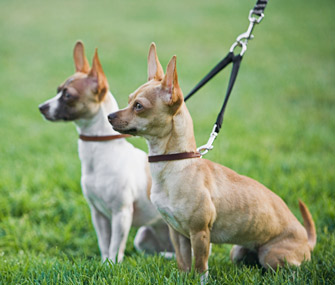How Do I Walk Two Dogs at Once?
Published on January 03, 2013

Q. How can I comfortably take two dogs on a walk without feeling pulled in multiple directions?
A. Walking two dogs at the same time is not always easy. Unless both dogs have been trained to walk calmly on leash individually, bringing them together on walks can be hazardous and can leave you feeling pulled in multiple directions — literally. But taking multiple dogs for a walk can save time and can be a bonding experience for you and your canines.
Only dogs who are calm and relaxed should be walked together, as dogs can pick up behavior problems from other dogs. If you have one barking and lunging dog, you can soon have two dogs with this behavior after walking them together, as they pick up behavior from other dogs. Only once the behavior problem has been addressed should another dog be added to the walk.
The right tools can also help you to manage multiple dogs. A double doggy leash that swivels and has one handle for both dogs lessens the chance of tangling, while a front clip harness can minimize pulling and make walks easier. But the best solution to this problem is some simple training.
Banish Pulling
If both dogs are friendly and relaxed but lack leash manners, leash training can make a dramatic difference. Teaching your dogs to walk on a loose leash and heel on command make walks more comfortable and controlled, whether you're walking your dogs individually or together. When both dogs understand loose leash walking and heel, they can more easily be walked together.
Pulling on the leash is natural for dogs because they have an opposition reflex, which causes them to pull back when they feel pressure on the leash. Even though it’s natural behavior, however, you can still train your dog that pulling on the leash doesn’t pay off. To combat this behavior, start your dogs' training with loose leash walking; work with each dog individually before bringing them together. Each time your dog pulls on the leash, stop walking; as soon as there is slack in the leash, start moving forward again. This teaches your dog that the walk only continues when he stays at your side, rather than lunging ahead.
Eventually your dogs will learn that only a loose leash gets them where they want to go. In order for the loose leash training to work, everyone who walks the dog must be consistent that pulling on the leash always stops the walk. No matter what the situation, whether going into doggy daycare or going on a morning walk, your dog should only make forward progress if there’s slack in the leash. For the practiced pullers, start walks in low distraction areas, such as inside your house, or in your back or front yard. Once your dog is walking on a loose leash in these familiar spaces, gradually increase the distractions by taking your dog on a walk around the block.
Time to Heel
Once your dogs have mastered the loose leash walk, it's time to work on heeling. In the heel position, your dog’s shoulder should be aligned with your leg. Use a clicker or a word to mark when your dog is in the right position; follow up with a tasty treat. Deliver the treat right next to your leg in the area you want the dog walking. Mark and reward the behavior frequently to help your dog understand the concept of staying by your side. It’s not unusual to treat every couple of steps when first training.
If your dog walks out in front of you, do something exciting, such as calling his name and turning in the other direction. As soon as he catches up with you and is in heel position, mark and reward. You may need to use a temporary food lure by your side to get your dog to target your leg area. The lure can then be faded by holding your empty hand as though it still has a treat in it as you continue to mark and reward your dog for proper position.
When your dog is staying reliably in position, add in the word “heel” just as he starts to walk by your side. Practice in low-distraction areas, such as in your home, before taking your dog outside. Teach your dog a release word, such as “free dog,” to let him know he can walk out in front of you again. Over time, randomly vary the amount of steps your dog takes in the heeling position before he is rewarded and released.
Get Your Dogs Together
Work with your dogs on alternating between walking on a loose leash and heeling until they can each readily perform both. Once both dogs have mastered these behaviors, it’s time to bring them together. Practice loose leash walking and heeling together in a low-distraction area. If one dog is distracted, go back to training and walking them separately. If needed, add the partner dog more gradually by having someone else walk one dog parallel to the dog you are walking but some distance away. As both dogs remain successful in their loose leash walking and heeling, they can gradually be brought closer until they are under control with only one person holding both leashes.
A loose leash can be used for most of the walk to allow both dogs to sniff and explore. The heel should be used when a significant distraction is present, such as an approaching dog or a street crossing. Mix loose leash walking and heeling throughout your walks until it becomes second nature for your dogs.





